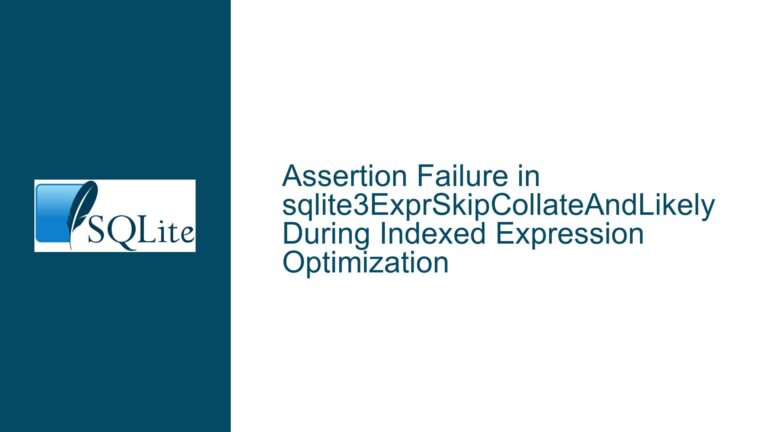SQLite Performance Degradation in JOIN Queries with NOT NULL Constraints
SQLite’s Full-Table Scan on IS NULL with NOT NULL Constraints
SQLite’s query planner exhibits a significant performance bottleneck when handling queries involving IS NULL conditions on columns with NOT NULL constraints. In such cases, SQLite performs a full-table scan instead of leveraging the NOT NULL constraint to optimize the query. This behavior is particularly problematic in large datasets, where the absence of optimization leads to disproportionately high execution times compared to other database systems like PostgreSQL, MySQL, and CockroachDB.
For example, consider a table t1 with a column a defined as NOT NULL. When executing a query like SELECT * FROM t1 WHERE a IS NULL;, SQLite scans the entire table, even though the NOT NULL constraint guarantees that no rows will satisfy the condition. This inefficiency is exacerbated in complex queries involving multiple joins and subqueries, where the planner fails to propagate the NOT NULL constraint information effectively.
The root cause lies in SQLite’s query compilation phase, where the planner does not utilize metadata about NOT NULL constraints to eliminate unnecessary scans. This issue is particularly evident in queries involving LEFT JOIN operations, where the planner fails to transform the join into an inner join when the join condition implies that the joined column cannot be NULL. For instance, in a query like SELECT * FROM t1 LEFT JOIN t2 ON t1.a = t2.x WHERE t2.y IS NULL;, SQLite does not recognize that t2.y cannot be NULL due to the NOT NULL constraint, resulting in a full scan of t2.
Subquery Correlation Misidentification in EXISTS Clauses
Another critical performance issue arises from SQLite’s handling of subqueries in EXISTS clauses. Specifically, SQLite misidentifies subqueries as correlated when they reference columns from outer queries, even when those columns do not affect the subquery’s result. This misidentification forces SQLite to execute the subquery repeatedly for each row in the outer query, leading to significant performance degradation.
Consider the following example:
CREATE TABLE t1(a, b);
CREATE TABLE t2(x, y);
SELECT * FROM t1 WHERE EXISTS (SELECT a FROM t2 WHERE x = 1);
In this query, the subquery SELECT a FROM t2 WHERE x = 1 is independent of the outer query’s rows. However, SQLite incorrectly treats the subquery as correlated due to the presence of a in the subquery’s result set. As a result, the subquery is executed for every row in t1, even though it could be executed just once.
This issue is compounded in queries involving multiple joins and complex conditions, where the planner’s inability to accurately determine subquery correlation leads to exponential increases in execution time. For example, in a query like:
SELECT * FROM t1 LEFT JOIN t2 ON t1.a = t2.x WHERE EXISTS (SELECT 1 FROM t3 WHERE t2.y IS NULL OR t3.c = 10);
SQLite fails to recognize that the EXISTS clause can be evaluated independently of the outer query, resulting in unnecessary repeated executions of the subquery.
Optimizing SQLite Query Performance with PRAGMA and Schema Refactoring
To address these performance issues, several strategies can be employed to optimize SQLite’s query execution. These strategies include leveraging SQLite’s PRAGMA directives, refactoring schema design, and rewriting queries to avoid known pitfalls.
Leveraging PRAGMA Directives
SQLite provides several PRAGMA directives that can be used to influence the query planner’s behavior. For example, enabling PRAGMA optimize before executing a query can help the planner make better decisions based on statistical information about the database. Additionally, PRAGMA journal_mode=WAL can improve write performance and reduce contention in multi-threaded environments, indirectly benefiting query performance.
Refactoring Schema Design
Refactoring the database schema to explicitly encode constraints and relationships can help the query planner make better optimization decisions. For example, ensuring that all NOT NULL constraints are explicitly defined allows the planner to eliminate unnecessary scans in queries involving IS NULL conditions. Similarly, using foreign key constraints can help the planner optimize join operations by providing additional metadata about table relationships.
Rewriting Queries for Optimal Performance
In cases where SQLite’s query planner fails to optimize a query effectively, manual query rewriting can often yield significant performance improvements. For example, rewriting a query to explicitly use INNER JOIN instead of LEFT JOIN when the join condition implies that NULL values are impossible can help the planner avoid unnecessary scans. Similarly, restructuring subqueries to eliminate unnecessary references to outer query columns can prevent misidentification of correlation.
Consider the following example:
SELECT * FROM t1 LEFT JOIN t2 ON t1.a = t2.x WHERE t2.y IS NULL;
This query can be rewritten as:
SELECT * FROM t1 INNER JOIN t2 ON t1.a = t2.x WHERE t2.y IS NULL;
By explicitly using INNER JOIN, the query planner can recognize that t2.y cannot be NULL due to the NOT NULL constraint, eliminating the need for a full scan of t2.
Implementing Indexes and Analyzing Query Plans
Creating appropriate indexes on columns involved in join conditions and WHERE clauses can significantly improve query performance. For example, adding an index on t2.x in the above query allows SQLite to quickly locate matching rows in t2, reducing the need for full-table scans. Additionally, using EXPLAIN QUERY PLAN to analyze the query execution plan can help identify inefficiencies and guide further optimizations.
For example, analyzing the query plan for:
EXPLAIN QUERY PLAN SELECT * FROM t1 INNER JOIN t2 ON t1.a = t2.x WHERE t2.y IS NULL;
can reveal whether SQLite is utilizing indexes effectively and whether additional optimizations are necessary.
Conclusion
SQLite’s performance issues in handling IS NULL conditions with NOT NULL constraints and misidentifying subquery correlation in EXISTS clauses are significant bottlenecks that can lead to orders-of-magnitude slower query execution compared to other database systems. By leveraging PRAGMA directives, refactoring schema design, rewriting queries, and implementing appropriate indexes, these issues can be mitigated to achieve optimal query performance. While SQLite’s query planner may not always make the best optimization decisions, understanding its limitations and applying targeted optimizations can help bridge the performance gap and ensure efficient query execution.






